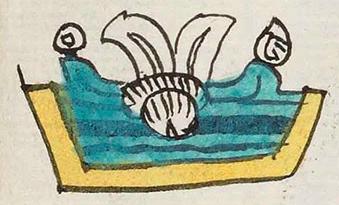Aztaapan (Mdz50r)
This compound glyph for the place name Aztaapan has two principal components, a white heron (aztatl)] feather device sitting on the cross-section of a water canal or channel (apantli). The latter is meant to provide the phonetic clue for the locative suffix -apan, "on or at the waters of." The trapezoid-shaped apantli has a yellow outline, which gives it some structure. The water in it is colored turquoise, and it has black lines of varying thickness (one especially thick one across the middle) presumably to show currents in the water. A white droplet (or perhaps a jade stone?) and a turbinate shell splash off the top of the water. The white heron feathers include two long ones, pointed upright, and a cluster of down feathers where they join at the base.
Stephanie Wood
The white heron feather device (or, alternatively, the snowy egret device) must have been instantly recognizable, important in the culture, and was therefore a simple way to point to the bird. Perhaps this was not only a place where herons were plentiful but where the local artisans made the white feather headdresses. The alternative use of the heron's head can be seen in other glyphs, which may make the use of the feather device significant here. The reference to being at or on the waters suggests that there is a river or lake that provided the habitat for the herons. Note how the apantli, when it does not have an object in or on it, will have more shells and droplets across the top of the water. Also, the lining of the canal or water ditch can vary in color and in the way it can be textured. (See below, right, for more examples of the apantli.)
Berdan and Anawalt note that the aztatl is identified as a snow egret (Leucophoyx thula) in Anderson and Dibble's translation of the Florentine Codex (1950–1982), Book 11, p. 28, and as the Ardea Occidentalis by Clark (1938, vol. 2, p. 53).
Stephanie Wood
aztaapan. puo
Aztaapan, pueblo
Stephanie Wood
c. 1541, or by 1553 at the latest
Stephanie Wood
herons, egrets, garzas, plumas blancas, aguas, feathers, nombres de lugares

azta(tl), Snowy Egret or the egret, https://nahuatl.wired-humanities.org/content/aztatl
aztaxel(li), double heron feather headdress, https://nahuatl.wired-humanities.org/content/aztaxelli
-apan (locative suffix), on or at the waters of, https://nahuatl.wired-humanities.org/content/apan-0
a(tl), water, https://nahuatl.wired-humanities.org/content/atl
"On the Canal of the White Heron" (presumably agreeing with Berdan and Anawalt) [Frances Karttunen, unpublished manuscript, used here with her permission.]
"At the Heron Waters" (SW); "On the Canal of the White Heron" (Berdan and Anawalt, 1992, vol. 1, p. 175; these authors spell the place name Azta Apan)
"En las Aguas de las Garzas"
Stephanie Wood
Codex Mendoza, folio 50 recto, https://digital.bodleian.ox.ac.uk/objects/2fea788e-2aa2-4f08-b6d9-648c00..., image 110 of 188.
The Bodleian Libraries, University of Oxford, hold the original manuscript, the MS. Arch. Selden. A. 1. This image is published here under the UK Creative Commons, “Attribution-NonCommercial-ShareAlike 3.0 License” (CC-BY-NC-SA 3.0).






